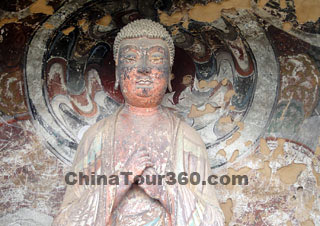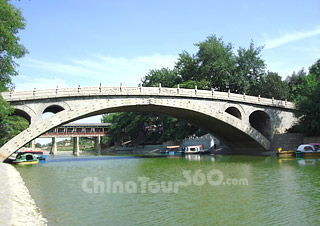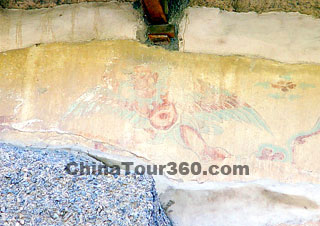Yangjian, known historically as Emperor Wen, established his regime during the Sui Dynasty, in 581. Yangjian was a distant relative of the Beizhou royal class, and usurped power from the hand of the last emperor in the Beizhou Kingdom of the Northern and Southern Dynasties (420 - 589). During his reign, Chang'an (present Xian City in Shaanxi Province) was the capital city.
The Sui Dynasty was short-lived under the second Emperor Yang's several tyrannical policies, and spanned only 38 years, from 581 to 618. During his reign, the Emperor demanded that his citizens build the Grand Canal-a monumental feat on ancient transportation engineering, and to reconstruct the capital-Chang'an City. The unbearable burden of taxes and compulsory labor led to a series of revolts which finally disintegrated the Sui Dynasty.
In 611, the peasant uprising led by Zhairang and Limi broke out in the Mt. Changbaishan area of Shandong Province. In 616, under the pressure of the chaotic situation Emperor Yang retreated to Jiangdu (present Yangzhou City in Jiangsu Province). In emperor's absence, Liyuan, a general among the aristocrats in the Sui Court, captured Chang'an City and established a new dynasty - the Tang Dynasty (618 - 907).
The Sui government re-established the centralized administrative system created by the Han Dynasty (206 BC - 220 AD). They set down the system of the 'Three Departments and Six Ministries' which strengthened the centralized power by focusing on cooperation and supervision between the different departments and ministries. This greatly enhanced the administrative efficiency. The dynasties thereafter all followed up this administrative system.
Emperor Wen set up the Imperial Examination System to curtail corruption by ensuring that officials were selected based on merits rather than by birth. The system of civil service examinations that began during the Sui Dynasty would be used by successive Chinese dynasties for the next 1,300 years.
![]() Economy
Economy
Many conflicts that took place during the Sui Dynasty led to a financial crisis throughout the country. The central government carried out a series of economical reform policies to try to combat the financial crisis which included a reinstatement of the Land Equalization System which distributed land according to the number of the people in each household. This policy aimed to reduce the gap between the rich and the poor. In permitting citizens to farm the land they owned and retain their land holdings, the farmer's passion enhanced resulting in the improvement of the agricultural productivity during the Sui Dynasty. Moreover, Emperor Wen levied lower taxes on the farmers and businessmen which also promote the development of social economy.
The Grand Canal was also constructed during the reigns of Emperor Wen and his son, Emperor Yang. The Canal project was created to improve the transportation condition between the south and the north of China, and was about 5,000 li (about 1,553 miles) long. The canal carved a path from northern China (Beijing) to Southern China (Hangzhou), passing through the central Luoyang City. This project connected the Yellow River with the Yangtze River and accelerated the economic and cultural exchanges between the two areas. The Beijing-Hangzhou Grand Canal continues to benefit people all over China. Sections of the Great Wall in Ningxia and Inner Mongolia were also constructed during this period in response to attacks from the Tujue (Turks) tribe.
![]() Religion
Religion

Buddha Statue in Mt. Maijishan
As the Sui Dynasty was founded during centuries of disunity, habits and customs varied throughout localities and cultures. Buddhism was encouraged throughout the country, as a means of unifying all groups. Chinese Buddhism blossomed during this period and the number of temples and monks rose dramatically. With the flourish of Chinese Buddhism, people in other countries like Japan came to China to study the religion which promoted the cultural exchanges between different nations.
![]() Foreign Relations
Foreign Relations
Foreign relations weakened during the Sui Dynasty, due to the long-lasting political turmoil, with the exception of the prosperous Silk Road which promoted exchange between China and the Western Asia and laid a foundation for relationships that would grow during the Tang Dynasty (618 - 907). Emperor Yang sent Pei Ju to the Western Regions to induce merchants to trade with the merchants in China. This consolidated the China's status and influence in the Asian arena during the Sui Dynasty.
![]() Art
Art
Artisan Li Chun developed the stone arch bridge (Zhaozhou Bridge) during the Sui Dynasty. This played an important role in world history, as a milestone in the development of bridges. Additionally, 60 percent of the statues of Buddha and delicate murals in the renowned Dunhuang Mogao Caves (located in the Gansu Province) were created during the Sui Dynasty.
|
|









